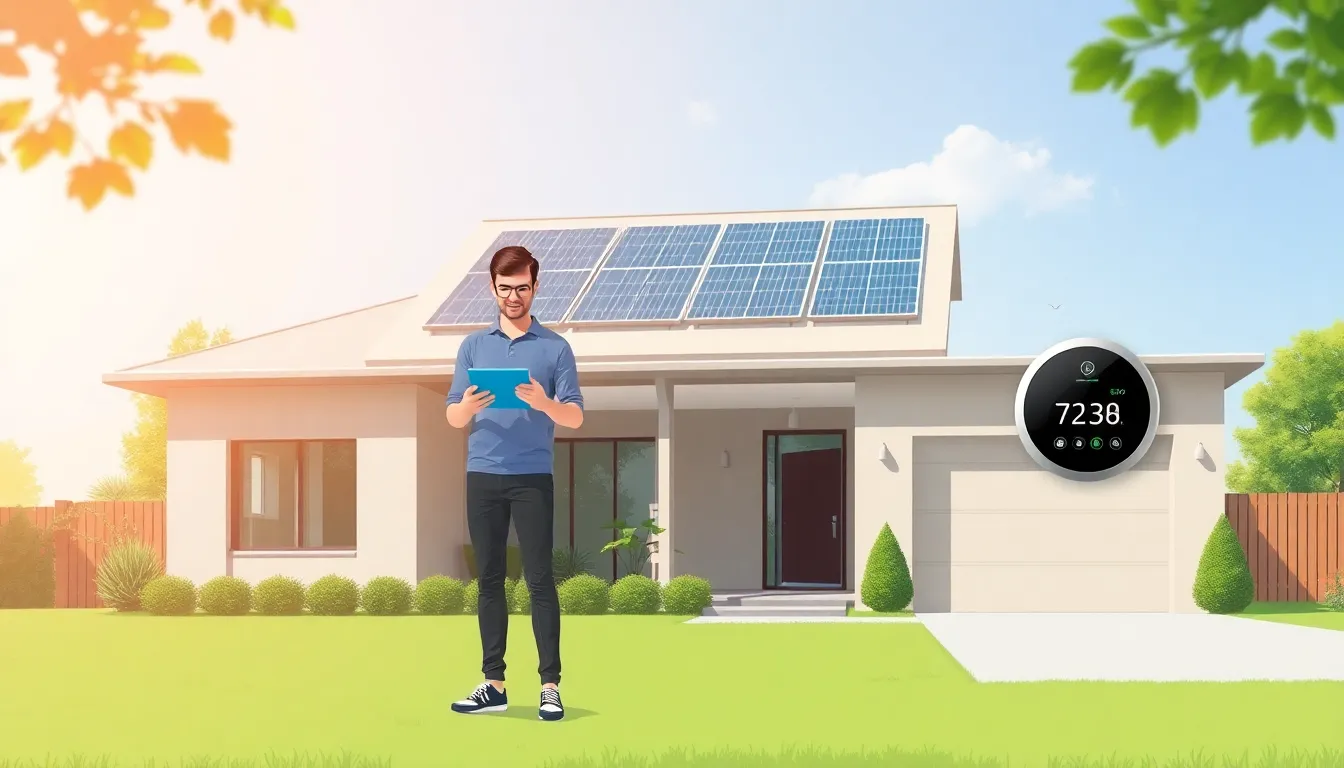Table of Contents
ToggleImagine a world where your home runs on sunshine and your energy bills are as low as your neighbor’s chances of winning the lottery. Welcome to the realm of solar smart living, where harnessing the sun’s power isn’t just for eco-warriors but for anyone who enjoys saving money while saving the planet.
Understanding Solar Smart Living
Solar smart living integrates solar energy systems into daily life, promoting efficient energy use. It encompasses technologies and practices that reduce reliance on traditional energy sources.
Definition of Solar Smart Living
Solar smart living involves the use of solar energy to power homes, contributing to energy independence. This approach emphasizes integrating solar panels, energy-efficient appliances, and smart home systems. Homeowners make informed decisions about energy consumption, optimizing sunlight availability to reduce energy costs. A solar smart lifestyle supports renewable energy and enhances environmental sustainability.
Importance of Sustainable Living
Sustainable living significantly impacts the health of the planet and future generations. By adopting solar smart living, individuals lower their carbon footprints while conserving natural resources. Energy efficiency reduces pollution and enhances air quality, benefiting communities. Communities with a focus on sustainable practices often experience economic growth, as solar energy jobs increase in demand. Embracing sustainable living fosters resilience against climate change, ensuring a stable environment for years to come.
Key Components of Solar Smart Living

Solar smart living incorporates essential elements that enhance energy efficiency and sustainability. Two of the most significant components include solar energy systems and smart home technology.
Solar Energy Systems
Solar panels capture sunlight and convert it into usable electricity. Many homeowners opt for photovoltaic systems due to their reliability and decreasing costs. Additionally, solar inverters play a critical role by converting direct current into alternating current for home use. Batteries can store excess energy generated during sunny days, ensuring power availability during cloudy periods. Evidence shows that integrating solar energy systems leads to substantial reductions in monthly energy bills. Choosing quality components ensures optimal performance and longevity.
Smart Home Technology
Smart home technology elevates solar smart living by automating energy management. Programmable devices help control energy consumption based on user routines and real-time data. Smart thermostats adjust heating and cooling automatically, optimizing energy use. Smart appliances, equipped with energy-efficient features, further enhance savings. Integration with solar systems allows users to monitor energy generation and usage through apps. The resulting data empowers homeowners to make informed decisions about their energy consumption, maximizing the benefits of solar energy.
Benefits of Solar Smart Living
Solar smart living offers numerous advantages that extend beyond individual households. These benefits play a vital role in promoting sustainability and financial efficiency.
Environmental Impact
Solar smart living significantly reduces carbon footprints. By utilizing solar energy, individuals contribute to lowering greenhouse gas emissions. Improved air quality results from decreased reliance on fossil fuels, fostering healthier communities. Wildlife habitats benefit from reduced land degradation due to less traditional energy extraction. Many studies highlight that widespread adoption of solar energy could cut global CO2 emissions by up to 70%. Engaging with solar technology empowers individuals to play an active role in combating climate change, ensuring a better environment for future generations. Enhanced biodiversity often follows as ecosystems thrive without the strain of pollution.
Economic Savings
Economic benefits arise from adopting solar smart living methodologies. Homeowners often experience reduced energy bills through decreased dependence on traditional power sources. Some users report savings of 50% or more on monthly electricity expenses. Incentives such as federal tax credits and state rebates can also lower the initial investment cost for solar systems. Solar technology often enhances property values, with homes equipped with solar panels selling for up to 20% more than comparable homes without them. Long-term savings accrue as solar energy becomes cheaper than grid electricity in many regions. Financial independence grows as individuals invest in self-sustaining energy systems.
Implementing Solar Smart Living
Implementing solar smart living involves several strategic steps to effectively harness solar energy and improve household efficiency.
Steps to Transition Your Home
Start by assessing energy consumption patterns. Reviewing monthly energy bills helps identify usage trends. Next, conduct a solar assessment to evaluate roof conditions and sunlight exposure. Choosing a reputable solar provider ensures quality installation. Consider financing options for solar systems, including loans or leases. These options often ease the upfront financial burden. Finally, monitor energy generation and efficiency regularly to optimize performance.
Choosing the Right Technology
Evaluate various solar technologies to determine the best fit. Look into photovoltaic (PV) panels, known for their reliability and decreasing prices. Compare inverter systems, as they convert sunlight into usable electricity. Energy storage solutions, like batteries, hold potential to use solar energy at night or during cloudy days. Assess smart home technology that integrates with solar systems, offering automated energy management. Prioritize systems that provide real-time data for efficient energy consumption.
Challenges and Considerations
Navigating solar smart living involves understanding associated challenges. Initial investment and ongoing maintenance require careful consideration.
Initial Investment
Investing in solar energy systems entails a significant upfront cost. Homeowners often face expenses related to purchasing panels, inverters, and installation services. Prices for solar panel systems can range from $15,000 to $30,000, depending on system size and installation complexity. Financial incentives from federal and state programs can help offset these costs. Furthermore, financing options such as solar loans or leases may alleviate immediate financial burden, making it more accessible for various budgets. Despite the high initial investment, long-term savings on energy bills often justify these costs.
Maintenance and Upkeep
Maintaining solar energy systems is crucial for optimal performance. Regular inspections ensure that solar panels remain clean and free from debris, which can hinder efficiency. Most systems require little maintenance; however, some components may need periodic replacement. Inverter lifespan averages about 5 to 10 years, necessitating budget considerations for potential replacement costs. Homeowners should also monitor system performance to identify any issues early. Investing in a monitoring system can help track energy production and identify malfunctioning components promptly, maximizing energy efficiency.
Embracing solar smart living represents a significant step towards a sustainable future. It empowers homeowners to take control of their energy consumption while reaping financial rewards. By integrating solar technology and smart home systems, individuals can optimize their energy use and contribute to a healthier planet.
As communities adopt these practices, they not only enhance their resilience against climate change but also pave the way for economic growth through the creation of green jobs. The transition to solar smart living is more than just a trend; it’s a commitment to a cleaner, more efficient way of life that benefits both current and future generations.




